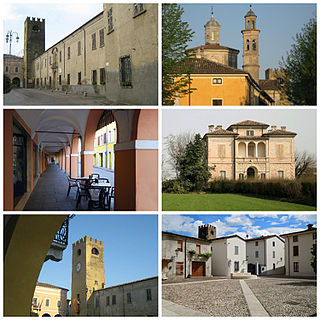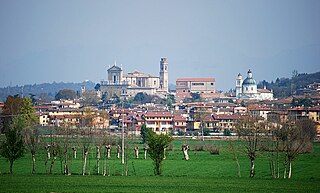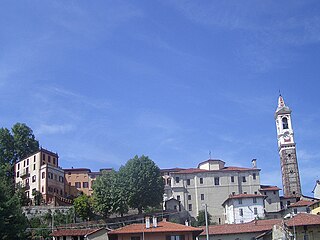
Mantua is a comune (municipality) in the Italian region of Lombardy, and capital of the province of the same name.

Solferino is a small town and municipality in the province of Mantua, Lombardy, northern Italy, approximately 10 kilometres (6.2 mi) south of Lake Garda.

Desenzano del Garda is a town and comune in the province of Brescia, in Lombardy, Italy, on the southwestern shore of Lake Garda. It borders the communes of Castiglione delle Stiviere, Lonato, Padenghe sul Garda and Sirmione.

Castel GoffredoItalian pronunciation:[kaˈstɛlɡofˈfreːdo] is a comune in the province of Mantua, in Lombardy, northern Italy, 35 kilometres (22 mi) from Mantua and a few more from Brescia. It lies in a region of springs at the foot of the slopes that drain into Lake Garda, towards the plain of the Po. Castel Goffredo borders the following municipalities: Castiglione delle Stiviere, Medole, Ceresara, Casaloldo, Asola, Acquafredda, Carpenedolo.

Lonato del Garda is a town and comune in the province of Brescia, in Lombardy, northern Italy. Lonato is located about halfway between Milan and Venice, on the southwest shore of Lake Garda, the biggest lake in Italy.

Castiglione delle Stiviere is a town and comune in the province of Mantua, in Lombardy, Italy, 30 kilometres northwest of Mantua by road.

Manerba del Garda is a town and comune in the province of Brescia, in Lombardy. It is located at the southwest side of the Lake Garda.

Polpenazze del Garda is a comune in the province of Brescia, in Lombardy, northern Italy. It is situated near the western shore of Lake Garda.

Peschiera del Garda is a town and comune in the province of Verona, in Veneto, Italy. When Lombardy-Venetia was under Austrian rule, Peschiera was the northwest anchor of the four fortified towns constituting the Quadrilatero. The fortress is on an island in the river Mincio at its outlet from Lake Garda.

Asola is a comune in the province of Mantua, Lombardy. It received the honorary title of city with a presidential decree of October 23, 1951.

Piadena is a former comune in the Province of Cremona, Italy. On January 1, 2019 it merged with Drizzona to form Piadena Drizzona.

Azeglio is a comune (municipality) in the Metropolitan City of Turin in the Italian region Piedmont, located about 45 kilometres (28 mi) northeast of Turin.

Medole is a comune (municipality) is an Italian municipality of 4,122 inhabitants in the province of Mantua in Lombardy.

Monzambano is a comune (municipality) in the Province of Mantua in the Italian region Lombardy, located about 120 kilometres (75 mi) east of Milan and about 25 kilometres (16 mi) northwest of Mantua. Its frazione of Castellaro Lagusello is one of I Borghi più belli d'Italia.

Volta Mantovana is a comune (municipality) in the Province of Mantua in the Italian region Lombardy, located about 120 kilometres (75 mi) east of Milan and about 20 kilometres (12 mi) northwest of Mantua.
The Polada culture is the name for a culture of the ancient Bronze Age which spread primarily in the territory of modern-day Lombardy, Veneto and Trentino, characterized by settlements on pile-dwellings.

Ledro is an Italian comune (municipality) in Trentino in northern Italy. It was created on January 1, 2010, by the union of the former comuni of Pieve di Ledro, Bezzecca, Concei, Molina di Ledro, Tiarno di Sopra and Tiarno di Sotto.

The Rocca di Manerba del Garda is a rocky promontory, that extends along the south-western coast of Lake Garda, in Lombardy, Italy. The site, named after its medieval fortification period, is archaeologically significant, with human occupation evidenced from the Mesolithic, Neolithic, Bronze Age, Iron Age, ancient Roman and Medieval periods. Archaeological features include the ruins of this medieval fortification on the summit, and, on the south-western side of the peninsula, the remains of an ancient Roman villa. It consists of two main peaks: the Rocca Vecchia and the hill with the hermitage of San Giorgio.

Mantuan cuisine is the set of traditional dishes of the Italian province of Mantua, some of which date back to the time of the Gonzaga.

Upper Mantua is a geographical area located northwest of the city of Mantua in the province of the same name and bordering the provinces of Brescia and Verona, bordered to the north by the morainic hills of Lake Garda, to the east by the province of Verona, to the northwest by the province of Brescia, and to the south by the plains of Middle Mantua.


























